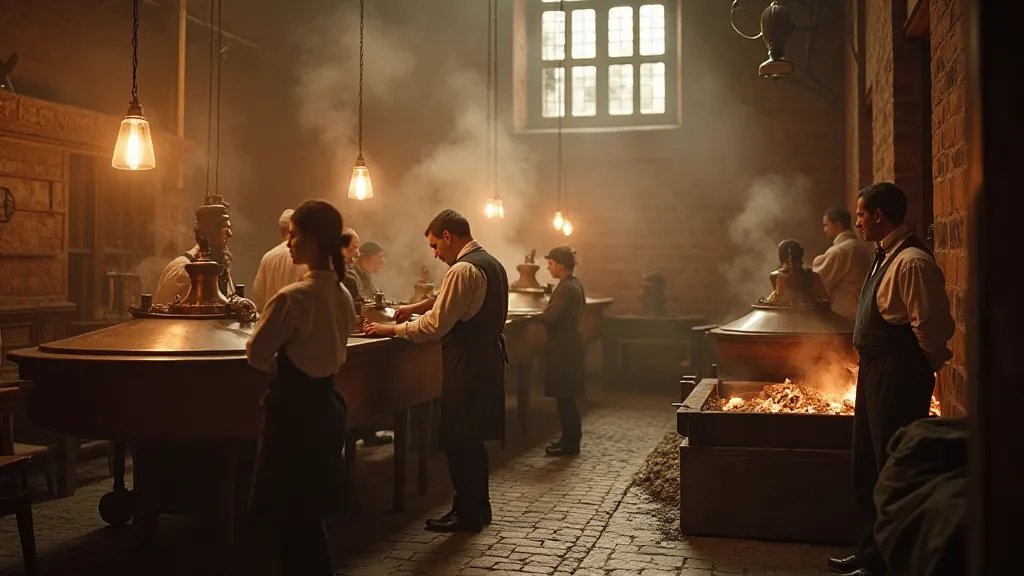Fermentation's Alchemy: How Science & Serendipity Defined Craft Beer's Evolution
The clinking of glass bottles, the rich aroma of malt and hops – these are the sensory hallmarks of a craft brewery. But the story of how those breweries came to be isn't simply about taste and trend. It's a narrative woven from threads of scientific breakthrough, accidental discovery, and a stubborn devotion to tradition, often echoing the soulful strains of a forgotten accordion, its bellows rising and falling in time with the ebb and flow of innovation.
To understand the modern craft beer scene, we must first rewind the clock, far beyond the hazy IPAs and vibrant sours of today. For centuries, beer wasn't just a beverage; it was a vital part of life, a safer alternative to often-contaminated water. Early brewing practices, though often imprecise, were rooted in a surprisingly intuitive understanding of fermentation – a process still shrouded in a touch of mystery. Thinkers and monks diligently documented what they observed, painstakingly tracking the impact of ingredients and conditions, laying the groundwork for what would eventually become formalized brewing science. This dedication to observation and documentation also shaped the cultural identity linked to brewing, something explored further in Fermenting Memory: The Microbes of Place and the Alchemy of Local Identity.
From Monasteries to Mass Production: A Century of Change
The medieval period saw monasteries become centers of brewing excellence. Monks weren't just brewing beer; they were experimenting. They meticulously recorded their observations, leading to the refinement of recipes and brewing techniques. This knowledge, initially guarded closely, gradually diffused into the wider community. The rise of the industrial revolution, however, brought a seismic shift. The advent of mechanized processes and a focus on efficiency led to homogenization. Mass-produced beers, consistent in flavor and appearance, dominated the market. Variety dwindled, and the artistry of brewing seemed destined for obsolescence.

This wasn’t a sudden collapse, but a slow dimming of the flame. Families who had brewed for generations found themselves struggling to compete with the large breweries. The heart of brewing felt… lost. There was a sense, especially amongst those who deeply cherished the old ways, that something precious was being sacrificed at the altar of efficiency.
The Reinheitsgebot and its Unintended Consequences
The Bavarian Reinheitsgebot, the 1516 beer purity law, while initially intended to standardize beer production and protect consumers, inadvertently contributed to the homogenization of styles. Limiting ingredients to barley, hops, and water (with yeast being later understood) effectively boxed in brewers, restricting experimentation and innovation. While this law fostered a certain level of quality and consistency, it also limited the scope of what beer could be. The narrowing of styles also impacted the history of beloved beer types – a lament worthy of further exploration in The Lager's Lament: A Requiem for Lost Beer Styles & Forgotten Brewers.
The American Revolution: A Seed of Change
The repeal of prohibition in 1933 provided a brief, chaotic rebirth for the American brewing industry. However, the dominant trend remained large-scale production and a focus on readily replicable styles. It wasn’t until decades later that the seeds of the craft beer revolution began to sprout. A small group of passionate individuals, many of whom were homebrewers, began to question the status quo. They sought to reclaim the lost art of brewing, to bring back the diversity and complexity that had been sacrificed in the name of mass appeal.
Think of it like an antique accordion, gathering dust in an attic. It represents a bygone era, a connection to a richer, more expressive past. Someone, compelled by a deep longing for something more, dusts it off, examines its intricate workings, and begins to coax melodies from its keys. That is precisely what these early craft brewers did. They meticulously studied the historical records, experimented with different ingredients and techniques, and, most importantly, listened to their instincts.
The Pioneers: Karl Strauss, Fritz Koser, and the Return of Flavor
Karl Strauss, a German immigrant, is often credited as one of the first American craft brewers. In the 1970s, he started brewing beers that were noticeably different from the bland lagers that dominated the market. His beers, with their bolder flavors and wider range of styles, appealed to a growing number of consumers who were tired of the same old thing. Fritz Koser, another German immigrant, similarly challenged the brewing establishment with his unique and flavorful beers. These pioneers, operating on a shoestring budget and facing considerable opposition from the established breweries, laid the foundation for what would become a global movement. Their legacy continues to shape the social spaces associated with breweries – the very taprooms themselves, as explored in “The Taproom's Tapestry: Examining the Social Hubs of Local Breweries”.
The Scientific Renaissance: Understanding Fermentation
The true engine driving the craft beer renaissance was a growing understanding of the science behind fermentation. Advances in microbiology allowed brewers to isolate and cultivate specific yeast strains, allowing for unprecedented control over flavor profiles. The ability to study enzymes and their impact on the brewing process opened up new avenues for innovation. This wasn't just about following recipes; it was about understanding the fundamental principles that governed the transformation of raw ingredients into delicious beer.

This newfound scientific rigor didn't stifle creativity; it enhanced it. Brewers were able to experiment with new ingredients, such as exotic fruits and spices, knowing that they could predict and control the impact of these additions on the final product. They could also fine-tune their brewing techniques, optimizing conditions to achieve specific flavor characteristics. It was a blending of tradition and innovation, of artistry and science. The terroir of a region also heavily influences the hops used – something intrinsically linked to a region's identity, as detailed in "The Hops' Legacy: How the Cultivation of Hops Defined a Region’s Identity".
The Rise of the Craft Beer Movement
The 1980s and 1990s witnessed an explosion of craft breweries across the United States. The Homebrewers Association played a crucial role in fostering this movement, providing a platform for homebrewers to connect, share knowledge, and showcase their creations. The rise of specialty beer stores further fueled the demand for craft beer, providing consumers with access to a wider range of styles and flavors. The story echoes the restoration of a beloved instrument – an old accordion painstakingly brought back to life, its bellows rising and falling with a renewed vibrancy.
The impact of these early pioneers reverberates through the industry today. The dedication to quality ingredients, coupled with the relentless pursuit of innovation, has created a vibrant and dynamic landscape of craft breweries across the globe. The evolution of brewing techniques has also allowed for the creation of incredibly diverse and flavorful beers, pushing the boundaries of what beer can be. From hazy IPAs to barrel-aged stouts, the possibilities seem truly endless, representing a constant rediscovery of ancient methods combined with modern scientific understanding. The ongoing quest for that perfect brew demonstrates the remarkable synergy between human ingenuity and the natural processes of fermentation. The legacy of Karl Strauss and Fritz Koser continues to inspire a new generation of brewers, dedicated to upholding the standards of quality and creativity that define the craft beer movement. This includes not only the production of exceptional beer but also the cultivation of a culture that celebrates craftsmanship, community, and the unwavering pursuit of flavor.

The future of craft beer appears bright, with new breweries and innovative brewing techniques emerging constantly. As consumers continue to seek out unique and flavorful experiences, the demand for handcrafted beverages is only expected to grow. The passion and dedication of these individuals are a testament to the enduring appeal of handcrafted beverages and a vibrant celebration of the alchemy that transforms simple ingredients into something truly extraordinary. Furthermore, this movement underscores the importance of preserving the traditions of craftsmanship and celebrating the human connection to the process of creation. It represents more than just a trend; it is a return to a time when quality, artistry, and community were the hallmarks of every product. The continued evolution of the craft beer movement ensures that the legacy of the pioneers will live on, inspiring future generations to push the boundaries of what beer can be and to create experiences that bring people together through the shared love of exceptional flavor.




![Hops & Harmony: How Immigration Shaped the Brewing Traditions of [Region]](/thumbs/hops-harmony-immigration-beer-traditions.webp)
